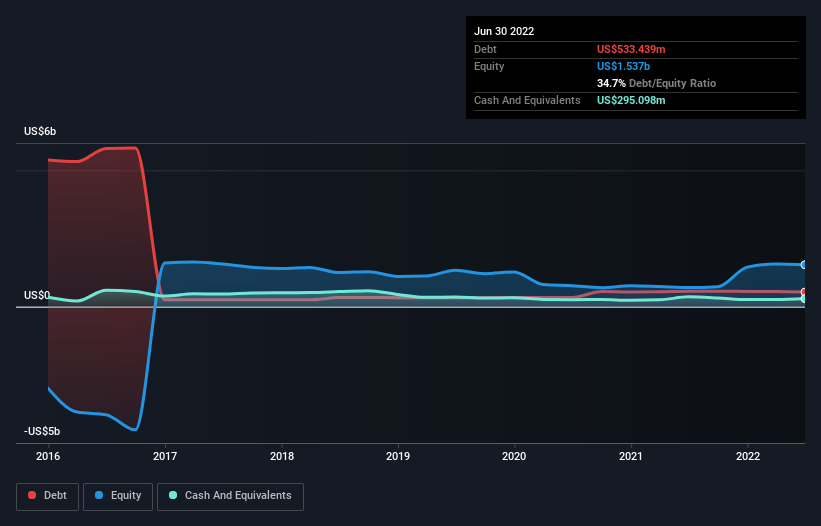Howard Marks put it nicely when he said that, rather than worrying about share price volatility, 'The possibility of permanent loss is the risk I worry about... and every practical investor I know worries about.' When we think about how risky a company is, we always like to look at its use of debt, since debt overload can lead to ruin. We note that Frontera Energy Corporation (TSE:FEC) does have debt on its balance sheet. But the real question is whether this debt is making the company risky.
When Is Debt Dangerous?
Debt and other liabilities become risky for a business when it cannot easily fulfill those obligations, either with free cash flow or by raising capital at an attractive price. Part and parcel of capitalism is the process of 'creative destruction' where failed businesses are mercilessly liquidated by their bankers. However, a more usual (but still expensive) situation is where a company must dilute shareholders at a cheap share price simply to get debt under control. Of course, debt can be an important tool in businesses, particularly capital heavy businesses. The first thing to do when considering how much debt a business uses is to look at its cash and debt together.
View our latest analysis for Frontera Energy
What Is Frontera Energy's Debt?
As you can see below, Frontera Energy had US$533.4m of debt at June 2022, down from US$567.9m a year prior. On the flip side, it has US$295.1m in cash leading to net debt of about US$238.3m.

How Strong Is Frontera Energy's Balance Sheet?
According to the last reported balance sheet, Frontera Energy had liabilities of US$582.4m due within 12 months, and liabilities of US$527.5m due beyond 12 months. Offsetting this, it had US$295.1m in cash and US$120.5m in receivables that were due within 12 months. So it has liabilities totalling US$694.2m more than its cash and near-term receivables, combined.
This deficit is considerable relative to its market capitalization of US$701.5m, so it does suggest shareholders should keep an eye on Frontera Energy's use of debt. Should its lenders demand that it shore up the balance sheet, shareholders would likely face severe dilution.
In order to size up a company's debt relative to its earnings, we calculate its net debt divided by its earnings before interest, tax, depreciation, and amortization (EBITDA) and its earnings before interest and tax (EBIT) divided by its interest expense (its interest cover). This way, we consider both the absolute quantum of the debt, as well as the interest rates paid on it.
Frontera Energy's net debt is only 0.21 times its EBITDA. And its EBIT easily covers its interest expense, being 23.4 times the size. So you could argue it is no more threatened by its debt than an elephant is by a mouse. Although Frontera Energy made a loss at the EBIT level, last year, it was also good to see that it generated US$962m in EBIT over the last twelve months. There's no doubt that we learn most about debt from the balance sheet. But ultimately the future profitability of the business will decide if Frontera Energy can strengthen its balance sheet over time. So if you're focused on the future you can check out this free report showing analyst profit forecasts.
Finally, a business needs free cash flow to pay off debt; accounting profits just don't cut it. So it is important to check how much of its earnings before interest and tax (EBIT) converts to actual free cash flow. In the last year, Frontera Energy created free cash flow amounting to 11% of its EBIT, an uninspiring performance. That limp level of cash conversion undermines its ability to manage and pay down debt.
Our View
Even if we have reservations about how easily Frontera Energy is capable of staying on top of its total liabilities, its interest cover and net debt to EBITDA make us think feel relatively unconcerned. Taking the abovementioned factors together we do think Frontera Energy's debt poses some risks to the business. So while that leverage does boost returns on equity, we wouldn't really want to see it increase from here. When analysing debt levels, the balance sheet is the obvious place to start. However, not all investment risk resides within the balance sheet - far from it. For instance, we've identified 1 warning sign for Frontera Energy that you should be aware of.
When all is said and done, sometimes its easier to focus on companies that don't even need debt. Readers can access a list of growth stocks with zero net debt 100% free, right now.
New: AI Stock Screener & Alerts
Our new AI Stock Screener scans the market every day to uncover opportunities.
• Dividend Powerhouses (3%+ Yield)
• Undervalued Small Caps with Insider Buying
• High growth Tech and AI Companies
Or build your own from over 50 metrics.
Have feedback on this article? Concerned about the content? Get in touch with us directly. Alternatively, email editorial-team (at) simplywallst.com.
This article by Simply Wall St is general in nature. We provide commentary based on historical data and analyst forecasts only using an unbiased methodology and our articles are not intended to be financial advice. It does not constitute a recommendation to buy or sell any stock, and does not take account of your objectives, or your financial situation. We aim to bring you long-term focused analysis driven by fundamental data. Note that our analysis may not factor in the latest price-sensitive company announcements or qualitative material. Simply Wall St has no position in any stocks mentioned.
About TSX:FEC
Frontera Energy
Engages in the exploration, development, production, transportation, storage, and sale of oil and natural gas in South America.
Good value with adequate balance sheet.
Similar Companies
Market Insights
Community Narratives



